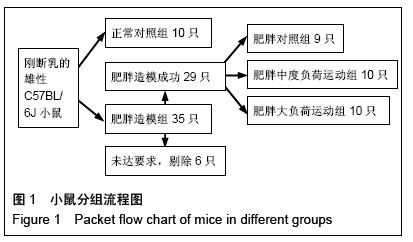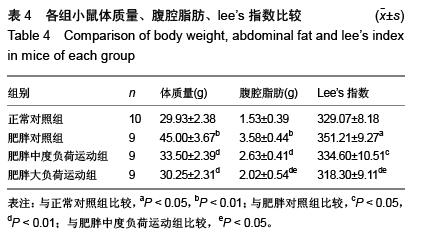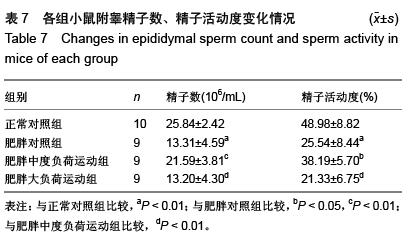| [1] Jensen TK, Andersson AM, Jorgensen N,et al. Body mass index in relation tosemen quality and reproductive hormones among 1,558 Danishmen.Fertil Steril.2004;82(4): 863-870.
[2] Wagner IV, Sabin MA, Pfäffle RW, et al. Effects of obesity on human sexual development.2012;8(4):246-254.
[3] 李田华,张春香.单纯性肥胖对青春期前男童性发育的影响[J].实用儿科临床杂志,2009,20(5):1574 -1575.
[4] Martini AC. Overweight and seminal quality: a study of 794 patients.J Urol. 2011;185(5):1838-1839.
[5] Traish AM, Feeley RJ, Guay A. Mechanisms of obesity and related pathologies: androgen deficiency and endothelial dysfunction may be the link between obesity and erectile dysfunction.FEBS J.2009;276(20):5755–5767.
[6] 于海涛,王舒然.肥胖对男性生殖功能影响机制的探讨[J].吉林医药学院学报,2014,35(1):55-58.
[7] 李长宇,徐蓉,朱海燕,等. 食源性肥胖对SD大鼠生殖能力的影响[J].实验动物科学, 2013,30(6):17-20.
[8] 翟玲玲,白霞,赵剑,等. 膳食诱导肥胖小鼠血清瘦素及性激素水平[J].环境与健康杂志,2013,30(11):950-952.
[9] Vigueras-Villaseñor RM,Rojas-Castañeda JC,Chávez-Saldaña M, et al. Alterations in the spermatic function generated by obesity in rats.Acta Histochem.2011;113(2): 214-220.
[10] Chavarro JE, Toth TL, Wright DL, et al. Body mass index in relation to semen quality, sperm DNA integrity, and serum reproductive hormone levels among men attending an infertility clinic. Fertil Steril.2010;93(7):2222-2231.
[11] Wagner IV, Sabin MA, Pfäffle RW, et al. Effects of obesity on human sexual development. Nat Rev Endocrinol.2012;8(4): 246-54.
[12] 胡学梅.不同运动量训练对大鼠血睾酮及相关指标的影响[J].体育学刊,2001,3:6-7.
[13] 刘高峰,胡小梅,王春景,等.氯化镧对雄性小鼠精子质量及睾丸酸活力的影响[J].四川动物,2012,31(3):471-473.
[14] 刘芳,高南南,杨润梅,等.不同品系小鼠肥胖模型比较及C57BL/6J小鼠肥胖机制研究[J].中国药理学通报,2013,29(3): 360-365.
[15] Volek JS, Vanheest JL, Forsythe CE. Diet and Exercise for Weight Loss:a Review of Current Issues.Sports Med. 2005; 35(1):1-9.
[16] Henderson GC,Fattor JA,Homing MA, et al. Lipolysis and Fatty Acid Metabolism in Men and Women during the Post exercise Recovery Period.J Physiol.2007;584(3):963-981.
[17] 汲智勇,杜晓平,符谦.七周有氧运动对高脂膳食大鼠体脂和血脂的影响[J].沈阳体育学院,2010,29(4):69-73.
[18] Levin BE,Dunn-Meynell AA.Differential effects of exercise on body weight gain and adiposity in obesity-prone and resistantrats. Int J Obes (Lond).2006;30(6): 722-727.
[19] Rees MD, Kennet EC, Whitelock JM, et al.Oxidative dam-age to extracellular matrix and its role in human pathologies. Free Radical Biology and Medicine.2008; 44(12):1973-2001.
[20] 巩宗林,徐勇.苏州市中小学男生青春期发育与超重肥胖相关性分析[J].中国学校卫生. 2013,34(4):446-448.
[21] 孙佳音,应锋,韩晓冬.睾丸间质细胞中睾酮合成酶及蛋白表达的调控因子[J].生殖与避孕,2009,29(1):42-47.
[22] 翟玲玲,赵剑,白英龙,等.肥胖对小鼠生殖功能影响及与性激素关系[J]. 中国公共卫生,2011,27,(2):204-205.
[23] 王晔. 男人早衰,睾酮先知[J]. 新世纪周刊,2009,(19):104-105.
[24] 王启荣,杨则宜,李肃反,等. 游泳耐力训练及益气补肾中药对大鼠睾丸形态结构的影响[J].中国运动医学杂志,2003, 22(3): 263-267.
[25] 姚泰.生理学[M].5版.人民体育大学学报,2008:1480-1492.
[26] Zachwieja JJ, Hendry SL, Smith SR,et al.Villance Voluntary wheel running decreases Adiponectinse tissue mass and expression of leptin mRNA in casbome-mendel rats. Diabetes.1997;46:1159-1161.
[27] Svartberg J, von Miihlen D, Sundsfjord J, et al.Waist circumference and testosterone levels in community dwelling men.The Troms study.Eur J Epidemiol. 2004;19(7):657-663.
[28] 秦春梅,冯继,陆强,等.中青年肥胖男性血清睾酮水平的变化[J].医学临床研究,2011,28(3):429-430.
[29] Zamorano PL, Mahesh VB, de Sevilla LM, et al. Expression and localization of the leptin receptor in endocrine and neumendocrine tissues of the rat. Neumendocrinology. 1997; 65(3):223
[30] 姜文凯,应峰,陈钟元,等.“GnRH-A试验”观察剧烈运动后下丘脑对垂体--性腺轴和垂体--肾上腺轴的影响[J].体育科学, 1994, 14(2): 66-71.
[31] Cumming DC, Brunsting LA 3rd, Strich G, et al. Rep roductive hormone increase in response to acute exercise in men. Med Sci Sports Execs.1986;18: 369-373.
[32] Khoo J, Tian HH, Tan B, et al.Comparing Effects of Low- and High-Volume Moderate-Intensity Exercise on Sexual Function and Testosterone in Obese Men. J Sex Med.2013;10(7): 1823-1832.
[33] 常波.耐力运动对高脂膳食雄性肥胖大鼠脂肪组织OB-R mRNA表达和性发育的影响[J].北京体育大学学报, 2008,31(11): 1480-1492.
[34] Hakkinen K. Daily hormonal and neuromuscular responses to intensive strength training in 1 week Int.Sports Med. 1988; 94(6): 422-428.
[35] 杨则宜.我国优秀运动员血清睾酮水平及运动对血清睾酮的作用[J].中国运动医学杂志,1988,7 (2):70-73.
[36] 章晓霜.不同强度运动对去卵巢大鼠血清雌二醇水平的影响[J].首都体育学院学报. 2006,18(5):35-37.
[37] 孙华宾,刘雅峰,刘艳,等.男性不育者精浆及精子孔酸脱氢酶活性的研究[J].中华全科医学,2010,8(8):974,1011.
[38] Magnusdottir EV, Thorsteinsson T, Thorsteinsdottir S, et al. Persistent organ chlorines, sedentary occupation,obesity and human male subfer-tility.Human Reproduction.2005;20: 208-215.
[39] 赵世荣.影响精液质量的因素[J].职业与健康,2012,28(14): 1780-1782.
[40] 乔玉成,张红娟,卢向阳.补充五子壮阳汤对大运动量训练大鼠睾丸组织显微结构与血睾酮含量的影响[J].中国运动医学杂志, 2006,25(1):93-95.
[41] 孔令振,李静,任增金,等.生后不同发育阶段大鼠睾丸生精小管和间质细胞形态学的变化[J]. 泰山医学院学报,2009,30(8): 584-58 |
.jpg)





.jpg)
.jpg)
.jpg)
.jpg)